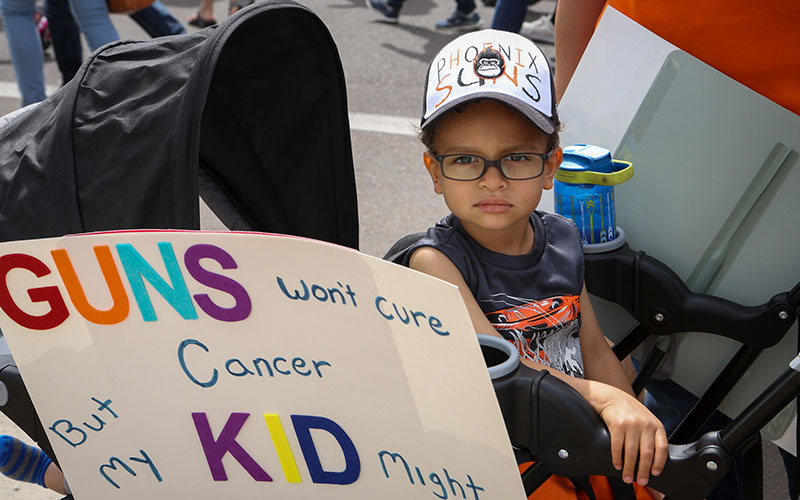
People watch opening speeches of the Phoenix March for Our Lives at the state Capitol. The event Saturday drew around 15,000 attendees, according to the Arizona Department of Public Safety. (Photo by Jenna Miller/Cronkite News)

Student leader Samatha Lekberg said she was so busy organizing the March For Our Lives that she didn’t have time to prepare remarks. “The future will be different because of everyone here,” she said. (Photo by Jenna Miller/Cronkite News)
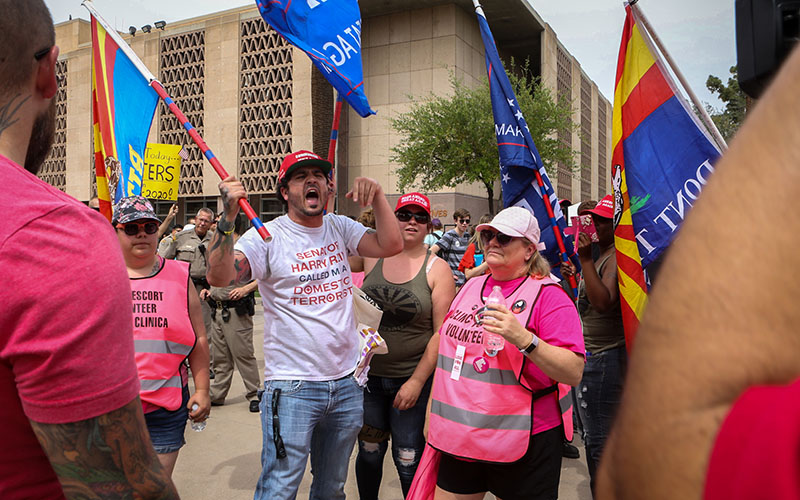
Counter-protestors argued with the those marching for gun control at the Phoenix March for Our Lives. Vann Gutier, center, said he came to the protest because he wants to “protect the Bill of Rights.” (Photo by Jenna Miller/Cronkite News)
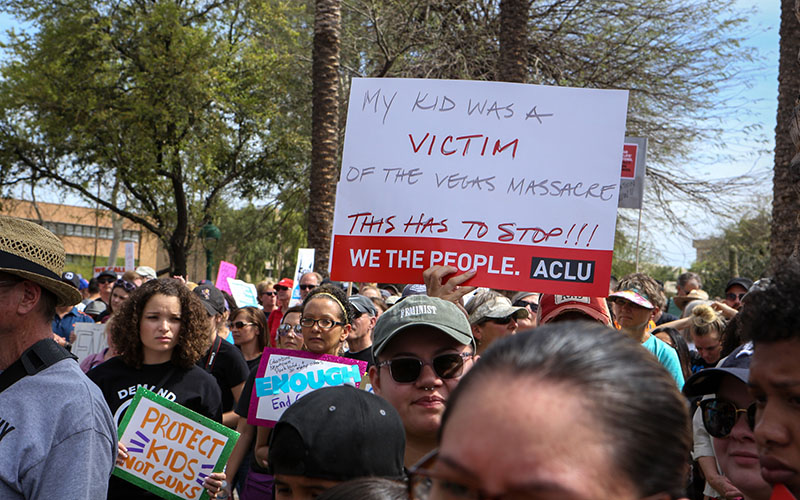
Jennifer Harper’s daughter was shot and injured in the 2017 Las Vegas shooting. “I feel like my generation has dropped the ball,” Harper said of her reason for coming out. “Kids deserve better, it’s that simple.” (Photo by Jenna Miller/Cronkite News)
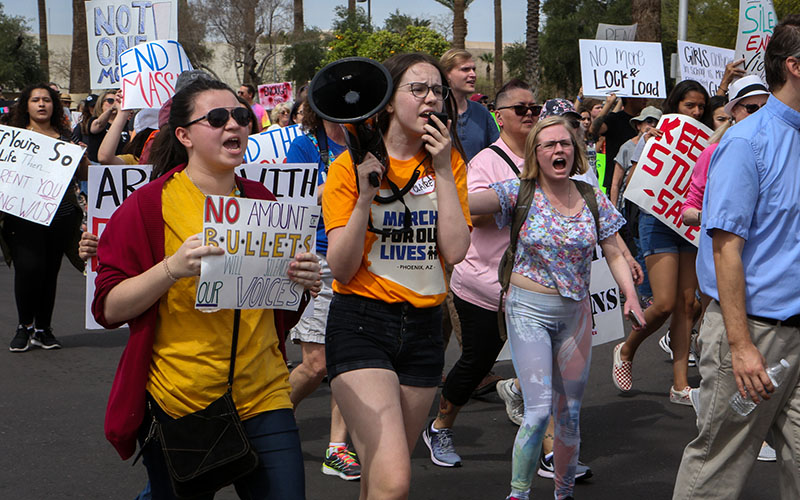
Saturday’s march was not the first for Claire Nelson, center. But the 15-year-old hopes “we don’t have to have another one (march) next year,” on guns. “That will mean that a change has been made.” (Photo by Jenna Miller/Cronkite News)
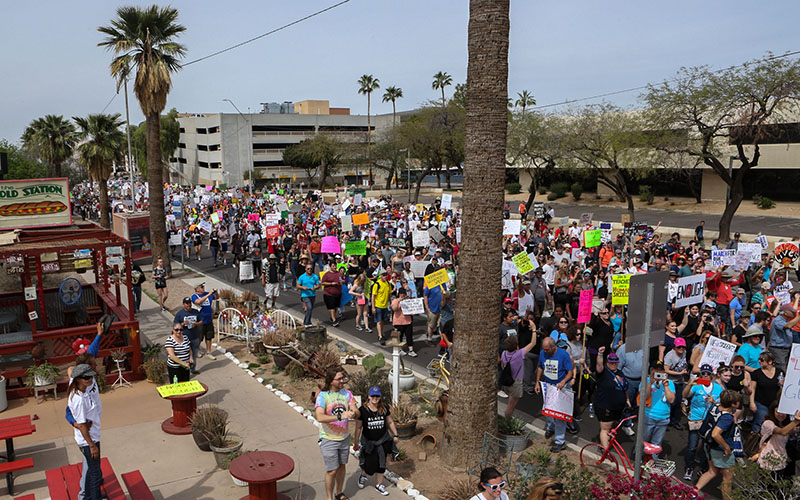
Protestors at the Phoenix March for Our Lives stretched down Jefferson Street. Law enforcement officials said the rally for school safety and stronger gun laws, drew about 15,000 people. (Photo by Jenna Miller/Cronkite News)
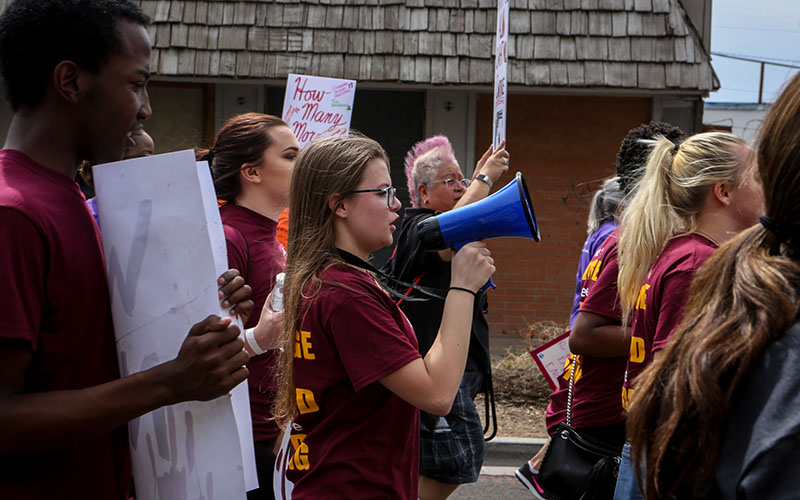
Jenna Barbash, 16, led Mountain Pointe High School students in chants of, “I will not be next,” as they walked the route of the Phoenix March for Our Lives, one of hundreds of such rallies nationwide. (Photo by Jenna Miller/ Cronkite News)
PHOENIX – “I will not be next! I will not be next!”
Thousands of people of all ages chanted their retort to gun violence at the Arizona Capitol on Saturday, a massive protest connected to hundreds of thousands of March for Our Lives activists in Washington, D.C., and across the nation.
They stood shoulder-to-shoulder, carrying such signs as “Protect Children.”
They signed up the young and the old at voter-registration booths, determined to make public officials enact more protections against gun violence.
And those from the student-led movement spoke from a stage, vowing to do everything to prevent another mass shooting like the one in Parkland, Florida, which spawned a national, youth-led movement of anger and determination.
“We refuse to live every day fearing that the next round of thoughts and prayers will be towards us,” said Jordan Harb, 17, a leader of Phoenix March for Our Lives. “For every young person here today, I implore you to understand … you are powerful.”
Related stories:
 • Students, parents, teachers pack D.C. streets at March for Our Lives
• Students, parents, teachers pack D.C. streets at March for Our Lives
• Giffords joins lawmakers, students at Capitol rally for March for Our Lives
• ‘Death is not new to us’: High school activists plan Phoenix March for Our Lives
Teenage survivors of the Parkland shooting founded March for Our Lives in the weeks after 14 students and three teachers and staff members were shot to death Feb. 14. Across the country and the world, more than 800 marches were held Saturday, including one in Phoenix with an estimated 15,000 people, according to the Arizona Department of Public Safety.
They marched on a warm spring day that hinted at summer, with the sun reaching through the clouds and a slight breeze blowing through the Capitol courtyard where thousands stood, protest signs in hand.
About 15 counter-protesters stood behind the crowd, waving “Make America Great Again” and “Don’t Tread on Me” flags, sidearms on their hips.
Casey Goble stood with the counterprotestors, an AR-15 strapped across his chest. The semiautomatic rifle has spurred controversy in the U.S. as the weapon often used in mass shootings, including the shooting at Marjory Stoneman Douglas High School in Parkland.
“I’m here standing up for my right and their right to carry,” he said, gesturing to the crowd. “They have a right to carry. They might not like it, but they have a right.”
Planned Parenthood peacekeepers in bright pink shirts and vests printed with the words “clinical escort volunteers” stood between the crowd and counterprotesters. The peacekeepers are trained in de-escalation techniques and volunteered to hold the line between the two groups, although people from each side sometimes shouted over them.
“You guys would rather have guns than our kids!” one woman screamed.
“Firearms can save our kids!” a man yelled back.
-Nicole Zeig said she came to the Phoenix March for Our Lives on behalf of her 2-year-old daughter. (Cronkite News video by Imani Stephens)
Jacob Martinez, 16, one of the leaders of March for Our Lives Phoenix, walked between the two groups. Martinez, 16, was chairman of the Arizona Teenage Republicans until he quit last week because of the party’s view on gun issues, he said.
Martinez took to the stage with other student leaders ahead of the march.
“The Governor’s Office is right here, and they’re going to hear us!” Martinez said, as the crowd roared and applauded.
Voter-registration volunteers scattered across the Capitol lawn and courtyard, grasping clipboards and paperwork.
Elena Williams, a grandmother and great-grandmother, said she volunteered to register voters because she wants to leave her grandchildren and great-grandchildren a world where they can “feel safe.”
“Registering to vote is your ability to express your opinion,” Williams said. “That’s the only way to express how we feel about politics.”
Voter registration was a major theme of the march, evident in the throng of registration volunteers and the speeches of the movement’s young leaders.
Samantha Lekberg, the 16-year-old founder of March for Our Lives Phoenix, ended her speech by referencing Gov. Doug Ducey’s refusal to meet with the protesters. Students staged a sit-in and delivered a statement to his office. Ducey later released a school safety proposal.
“Those legislators and senators and governors who aren’t meeting with people like they should be?” Lekberg said. “We can vote them out!”
The crowd responded with chants of “Vote them out!”
Faces from the march
Making her way through the crowd was Cappi Baumgart, 62, who was a teacher at Columbine High School in 1999 when two students shot 13 people to death before killing themselves.
Baumgart was trapped in a classroom with 60 students and three teachers, including coach Dave Sanders, who died in the attack.
“I would have hoped that 19 years later, there would be change and protection for our children and students,” Baumgart said.
While preparing for the march, she said she cried for the first time in a long time. She has carried grief and trauma for nearly two decades.
Finally, she said, she has hope.
“I’m energized by these kids from Florida. I’m energized by the marches,” she said.
Baumgart’s husband, Steve Baumgart, said he used to be a member of the National Rifle Association. He grew up in Montana and spent his childhood hunting and fishing. He no longer recognizes the NRA.
“I just can’t support guns with all the capacity they have,” Steve Baumgart said. “They’re to kill people.”
Steve Baumgart described himself as a “staunch Republican” but said he won’t vote the party line when it comes to gun issues.
Ken and Linda Bielek, both 76, traded off holding a sign that read “Protect Children.”
Ken Bielek believes AR-15s shouldn’t be available to civilians.
“They’re not for defense. They’re not for hunting. They’re for slaughter, and I know that as an Army veteran,” Bielek said.
-Priscilla Lianoz, an Arizona State University freshman, explains why she believes there will be change in the gun debate. (Cronkite News video by Megan Meier)
Linda Bielek nodded. She and her husband debated whether to attend the march, she said, because of their age and health issues but ultimately decided “we just could not sit home.”
The couple said they are energized seeing younger people take the reins of the gun control movement.
Some of the marchers were even younger than the teenage leaders. Alex Morrell, 30, brought her 3-year-old daughter, Dawson, to the march.
“I just want her to experience positive activism,” Morrell said. “I want her to see it from an early age.”
Morrell said she told her daughter they were going to march to keep her safe in school. It isn’t Dawson Morrell’s first march – she also went with her mother to the 2018 Women’s March.
“She just loves being around all the people and the good energy,” Morrell said.
Jennifer Harper attended the march for her daughter, who she said was injured in the Las Vegas shooting on Oct. 1, 2017, and is “still not well.” Harper held a sign that read “My kid was a victim of the Las Vegas massacre. This has to stop!”
She listened to the speakers with tears rolling down her face. She wiped them away and pulled her hat over her eyes.
“Kids should not be hunted,” she said. “Kids deserve better. My generation dropped the ball.”









